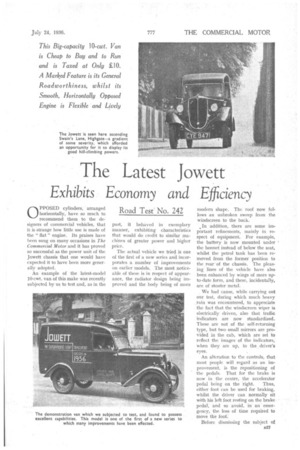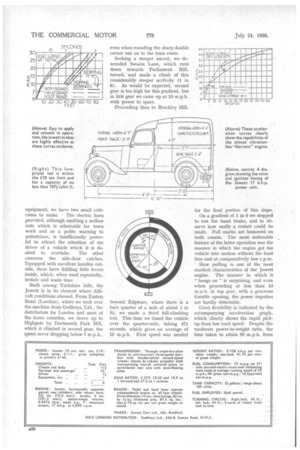The Latest jowett
Page 41

Page 42

Page 43

If you've noticed an error in this article please click here to report it so we can fix it.
Exhibits Economy and Efficiency
Road Test No. 242 OPPOSED cylinders, arranged horizontally, have so much to • recommend them to the designers of commercial vehicles, that it is strange how little use is made of the " flat " engine. Its praises have been sung on many occasions in The Commercial Motor and it has proved so successful as the power unit of the jowett chassis that one would have expected it to have been more generally adopted.
An example of the latest-model 10-cwt. van of this make was recently subjected by us to test and, as in the past, it behaved in exemplary manner, exhibiting characteristics that would do credit to similar machines of greater power and higher price.
The actual vehicle we tried is one of the first of a new series and incorporates a number of improvements on earlier models. The most noticeable of these is in respect of appearance, the radiator design being improved and the body being of more
modern shape. The roof now follows an unbroken sweep from the windscreen to the back.
In addition, there are some important refinements, mainly in respect of equipment. For example, the battery is now mounted under the bonnet instead of below the seat, whilst the petrol tank has been removed from the former position to the rear ofthe chassis. The pleasing lines of the vehicle have also been enhanced by wings of more upto-date form, and these, incidentally, are of stouter metal.
We had cause, while carrying out our test, during which much heavy rain was encountered, to appreciate the fact that the windscreen wiper is electrically driven, also that traffic. indicators are now standardized. These are not of the self-returning type, but two small mirrors are provided in the cab, which are set to reflect the images of the indicators, when they are up, to the . driver's eyes.
An alteration to the controls, that most people will regard as an improvement, is the repositioning of the pedals. That for the brake is now in the centre, the accelerator
pedal being on the right. Thus, either foot can be used for braking, whilst the driver can normally sit with his left foot resting on the brake pedal; and so avoid, • in as emergency, the loss of time required to move the foot: Before dismissing the subject of
equipment, we have two small criticisms to make. The electric horn provided, although emitting a mellow note which is admirable for town work and as a polite warning to pedestrians, is insufficiently powerful to attract the attention of the driver of a vehicle which it is desired to overtake. The other concerns the side-door catches. Equipped with excellent handles outside, these have fiddling little levers inside, which, when used repeatedly,
irritate and waste time. th
Built among Yorkshire hills, e jowett is in its element where. difficult conditions abound. From Euston Road (London), where we took over the machine from Godfreys, Ltd., the distributors for London and most of the home counties, we drove up to Highgate by Dartmouth Park Hill, which it climbed in second gear, the speed never dropping below 7 m.p.h., even whenronding the sharp double corner out u
on to the tram route.
Seeking a steeper ascent, we descended Swains Lane, which runs down towards Parliament . Hill, turned, and made a climb of this considerably steeper acclivity (1 in 6). As would be expected, second gear is too high for this gradient, but in first gear we came up at 10 m.p.h. with power to spare. Proceeding then to Brockley Hill, beyond Edgware, where there isa bare quarter of a mile of about 1 in 81, we made a third hill-climbing test. This time we limed the vehicle over the quarter-mile, taking 47i seconds, which gives an average of 19 m.p.h. First speed was needed
for the final portion of this slope.
On a gradient of 1 in 6 we stopped to test the hand brake, and to observe how easily a restart could be made. Full marks are bestowed on both counts. The most noticeable feature of the latter operation was the manner in which the engine got the vehicle into motion without the least fuss and at comparatively low r.p.m.
Slow pulling is one of the most marked characteristics of the jowett engine. The manner in which it " hangs on " is surprising, and even when proceeding at less than 10 m.p.h. in top gear, with a generous throttle opening, the power impulses are hardly detectable. Good flexibility is indicated by the ti acCompanying acceleration graph, which clearly shows the rapid pick low road up from ..speed. Despite the moderate power-to-weight ratio, the time taken to attain 30 m.p.h. from
stationary is well up to average. Good acceleration, moreover, is not obtained at the expense of speed capabilities, for advantage has been taken of the good torque qualities of the power unit to employ a fairly high axle ratio.
At " peak revs."-3,000 r.p.m.— the vehicle is travelling at 44 m.p.h., and as we found it to be capable of 35 m.p.h. in second gear, at which speed the engine is running ,at over 4,500 r.p.m., it is clear that, given easy conditions, a considerably higher speed is practicable.
Our brake tests showed the Jowett to be excellently equipped in this respect, and an unusual feature, upon which we have commented before, is that, .good as is the foot brake, the hand brake ti even better. Here again the influence of environment is apparent. First-rate handbrake and foot-brake equipment is indispensable where the daily round is among the steep hills of the West Riding, There are commercial
vehicle makers of greater prominence than the Jowett Company Who could learn something about brakes from these handy machines.
Included in our consumption test were the aceeleration trials and the measuring of turning circles. The route crossed the range of high ground south of Welwyn and fol lowed the undulating and winding road from this village to Hitchin.
The-return of 33 m.p.g. which we obtained is better than the average for a similar four-cylinder van, and although slightly below the figure we recorded for a Jowett on a previous occasion, is, without doubt, satisfactory, and might easily be improved upon in service. A van of this description is probably operated, for the major part of its life, with less than the full load.
From the point of view of Maintenance, the Jowett engine is simpler
than a "four." Each head can be removed separately and, of course, there is only half the number of
valves to attend to. The parts, generally speaking, are larger, which is an advantage, and, in the main, accessibility seems to be superior.
Highly roadworthy, pleasant to drive, easy to maintain and economical to run, the Jowett is, we believe, the lowest-priced 10-cwt. fourwheeler on the market, and the van is claimed to be of nearly double the capacity of any other similar vehicle within the £10 tax limit.




























































































